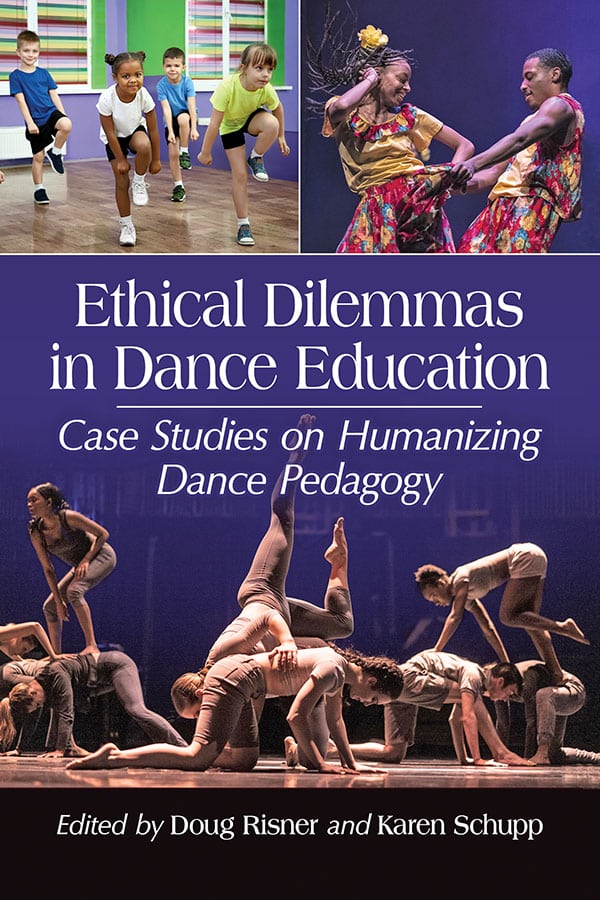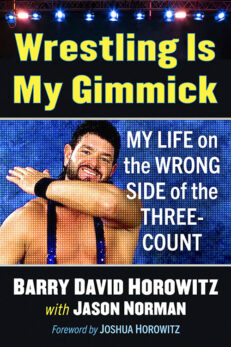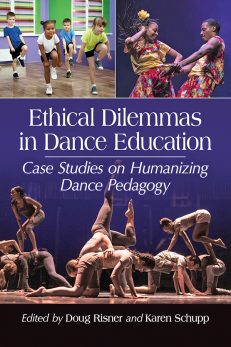Ethical Dilemmas in Dance Education
Case Studies on Humanizing Dance Pedagogy
$49.95
In stock
About the Book
The first of its kind, this volume presents research-based fictionalized case studies from experts in the field of dance education, examining theory and practice developed from real-world scenarios that call for ethical decision-making. Dilemmas faced by dance educators in the studio, on stage, in recreation centers and correctional facilities, and on social media are explored, accompanied by activities for humanizing dance pedagogy. These challenges converge from educational policies and mandates developed over the past two decades, including teacher-proof “scripted” curriculum, high-stakes testing, standardization, and methods-centered teacher preparation; difficulties are often perpetuated by those who want to make change happen but do not know how.
Instructors considering this book for use in a course may request an examination copy here.
About the Author(s)
Bibliographic Details
Edited by Doug Risner and Karen Schupp
Format: softcover (6 x 9)
Pages: 351
Bibliographic Info: appendices, bibliography, index
Copyright Date: 2020
pISBN: 978-1-4766-6717-1
eISBN: 978-1-4766-3738-9
Imprint: McFarland
Table of Contents
Acknowledgments v
Introduction: Doug Risner and Karen Schupp 1
Section One: Early Childhood and Elementary Dance Education
Section Editors: Theresa Purcell Cone and Susan W. Stinson
Section Introduction—Susan W. Stinson and Theresa Purcell Cone 10
Culture and Conflict: Planning a Dance Partnership—Marissa Beth Nesbit 16
Activity: What Parents Can Teach Us About Students—Karen Schupp and Doug Risner 26
The Ethics of Discussing Religious Beliefs in a Primary Dance Classroom—Becky Dyer and Susan W. Stinson 28
Activity: The Global Village—Doug Risner 37
Challenges and Solutions to Including Students with Disabilities—Theresa Purcell Cone, Doug Risner and Karen Schupp 40
Activity: What Body Dances?—Karen Schupp and Doug Risner 49
She Wants to Dance with the Boys—Monica J. Cameron Frichtel 51
Activity: Dancing Your Gender—Doug Risner and Karen Schupp 59
Values Inventory: Installment I—Doug Risner 62
Section Two: Middle School and High School Dance Education
Section Editor: Pam Musil
Section Introduction—Pam Musil 64
Dance in the Crossfire—Marissa Beth Nesbit with Adeena Lago 71
Activity: Changing Grades—Doug Risner 80
Dancing in Bars—Pam Musil 82
Activity: Uncovering Hidden Messages—Karen Schupp and Doug Risner 91
Waltzing with the Enemy—Kori Wakamatsu 93
Activity: Bystander Intervention: When It Is Your Business—Karen Schupp 101
Negotiating Challenges with Social Media: #overexposed—Kori Wakamatsu 103
Activity: Screens Out!—Doug Risner 112
American Ethnocentrism—Pam Musil 115
Activity: Whose America? Our America, of Course!—Karen Schupp and Doug Risner 125
The Imperfect Advocate: Supporting Transgender Students in the Dance Class—Marissa Beth Nesbit 127
Activity: Speaking Transgender—Karen Schupp 136
Values Inventory: Installment II—Doug Risner 138
Section Three: Dance Teacher Preparation and Postsecondary Dance Education
Section Editor: Elizabeth McPherson
Section Introduction—Elizabeth McPherson with Donna A. Dragon; Doug Risner and Karen Schupp 140
The Cultural Assumptions We Carry—Stephanie Milling 151
Activity: My Education Map—Doug Risner 160
Why Grade Inflation and Teacher Dispositions Don’t Mix—Elizabeth McPherson, Doug Risner and Karen Schupp 163
Activity: Honest Gestures—Karen Schupp 173
Confronting Urban Phobias—Elizabeth McPherson with Kathleen Isaac 176
Activity: Anti-Racism Boxes—Doug Risner 185
Whistleblowing Adolescent Sexual Abuse—Barbara Bashaw and Marissa Beth Nesbit 188
Activity: Doing the Right Thing or Doing Things Right?—Karen Schupp 197
Where to Draw the Line—Karen Schupp and Robin Prichard 199
Activity: Motivating Growth—Karen Schupp 208
When Department Policy Limits Teaching—Tanya Berg and Doug Risner 211
Activity: Make the Case—Doug Risner 220
Teaching Contact Improvisation: Touching and Being Touched—Tanya Berg and Doug Risner 223
Activity: Touchy Subjects—Doug Risner 233
Values Inventory: Installment III—Doug Risner 235
Section Four: Community Dance
Section Editors: Sherrie Barr and Miriam Giguere
Section Introduction—Sherrie Barr and Miriam Giguere 238
Whose Class Is It Anyway?—Sherrie Barr and Miriam Giguere with Mary Fitzgerald 245
Activity: Social Immersion Project—Doug Risner 254
Dancing Within Prison Walls—Sherrie Barr, Miriam Giguere and Susan Bendix 256
Activity: Critical Field Observations—Doug Risner 265
Intergenerational Moves—Sherrie Barr and Miriam Giguere with Susan Bendix 267
Activity: What Should Dance Education Look Like?—Doug Risner 276
Why Do I Have to Perform?—Miriam Giguere and Sherrie Barr 278
Activity: Performing Your Values—Karen Schupp and Doug Risner 286
Teaching Artist Advocates: The Difference We Can Make—Doug Risner and Karen Schupp 288
Activity: Heterosexual Questionnaire—Doug Risner 297
Values Inventory: Installment IV—Doug Risner 300
Appendix I: Teachers’ Guide 303
Appendix II: Field Observation Notes Template 305
Works Cited 311
About the Contributors 327
Index 331
Book Reviews & Awards
• Winner, Susan W. Stinson Book Award for Dance Education—University of North Carolina Greensboro
• Winner, Ruth Lovell Murray Book Award—National Dance Education Organization
• “Original and groundbreaking…. This is a pivotal text to propel dance education beyond the status quo tenants of ‘best practices.’…This text may well be the driver moving personal, value-based pedagogies beyond methods-based instruction. An exciting read and an honest journey in meaningful decision making.”—Susan Kirchner, Towson University
• “A superb edited collection of case studies that will transform dance teacher training by unpacking and asking key ethical questions. One of the most powerful and pedagogically profound aspects of the book includes reflective activities for developing humanizing dance pedagogies by revealing the complex nature of ethical decision making in dance teaching and education.”—College of Visual and Performing Arts, School of Dance University of North Carolina Greensboro
• A vital resource…beneficial…clearly organized…thoughtful discussion…Risner and Schupp have created a useful resource for any dance teacher that would be particularly beneficial in a dance pedagogy course or with preservice teachers in preparation programs.”—Journal of Dance Education





